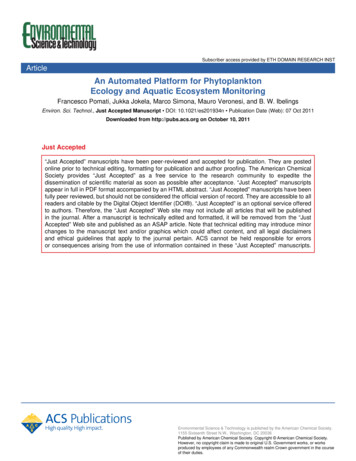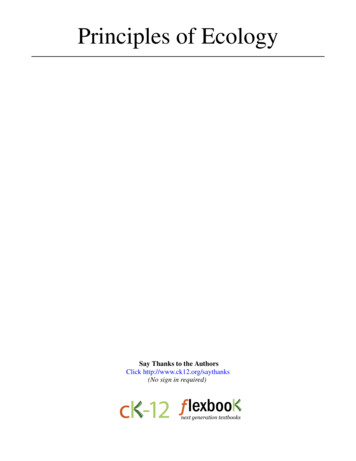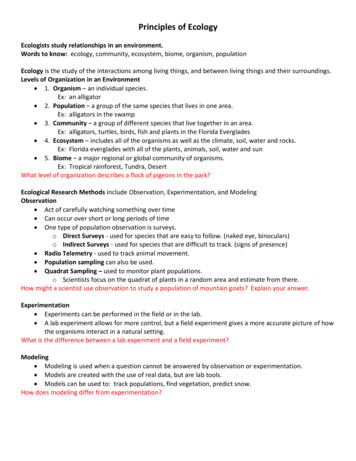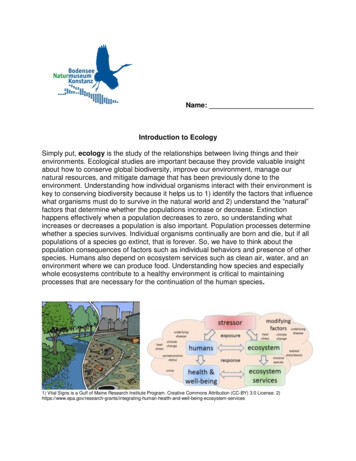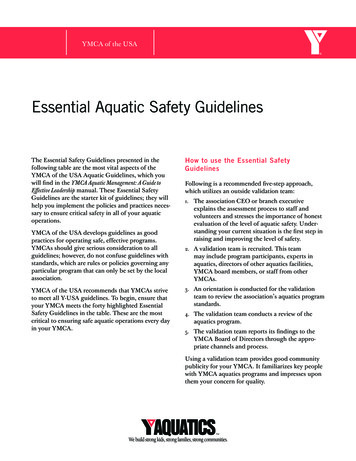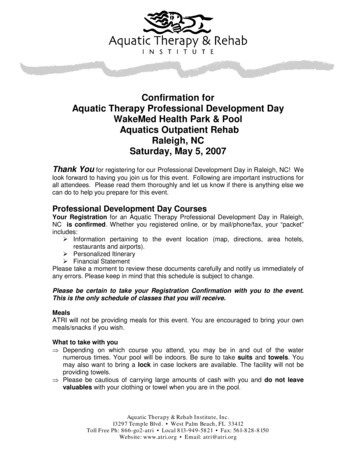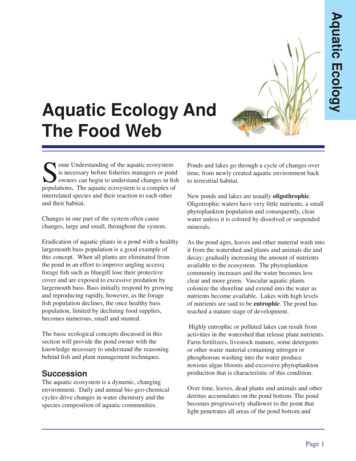
Transcription
Aquatic EcologyAquatic Ecology AndThe Food WebSome Understanding of the aquatic ecosystemis necessary before fisheries managers or pondowners can begin to understand changes in fishpopulations. The aquatic ecosystem is a complex ofinterrelated species and their reaction to each otherand their habitat.Changes in one part of the system often causechanges, large and small, throughout the system.Eradication of aquatic plants in a pond with a healthylargemouth bass population is a good example ofthis concept. When all plants are eliminated fromthe pond in an effort to improve angling access;forage fish such as bluegill lose their protectivecover and are exposed to excessive predation bylargemouth bass. Bass initially respond by growingand reproducing rapidly, however, as the foragefish population declines, the once healthy basspopulation, limited by declining food supplies,becomes numerous, small and stunted.The basic ecological concepts discussed in thissection will provide the pond owner with theknowledge necessary to understand the reasoningbehind fish and plant management techniques.SuccessionThe aquatic ecosystem is a dynamic, changingenvironment. Daily and annual bio-geo-chemicalcycles drive changes in water chemistry and thespecies composition of aquatic communities.Ponds and lakes go through a cycle of changes overtime, from newly created aquatic environment backto terrestrial habitat.New ponds and lakes are usually oligothrophic.Oligotrophic waters have very little nutrients, a smallphytoplankton population and consequently, clearwater unless it is colored by dissolved or suspendedminerals.As the pond ages, leaves and other material wash intoit from the watershed and plants and animals die anddecay; gradually increasing the amount of nutrientsavailable to the ecosystem. The phytoplanktoncommunity increases and the water becomes lessclear and more green. Vascular aquatic plantscolonize the shoreline and extend into the water asnutrients become available. Lakes with high levelsof nutrients are said to be eutrophic. The pond hasreached a mature stage of development.Highly eutrophic or polluted lakes can result fromactivities in the watershed that release plant nutrients.Farm fertilizers, livestock manure, some detergentsor other waste material containing nitrogen orphosphorous washing into the water producenoxious algae blooms and excessive phytoplanktonproduction that is characteristic of this condition.Over time, leaves, dead plants and animals and otherdetritus accumulates on the pond bottom. The pondbecomes progressively shallower to the point thatlight penetrates all areas of the pond bottom andPage 1
Aquatic EcologyPage 2
Aquatic Ecologyaquatic vegetation covers the waters surface. Thepond has reached the age of senescence.Willows, cypress, cattail and other shoreline plantsadvance toward the ponds center.Eventually rooted plants cover the pond bottomand the pond becomes a bog or marsh. Dry landtrees begin to invade areas that were once underwater. The marsh eventually fills in and drys up.Surrounding terrestrial vegetation replaces aquaticand semi-aquatic plant species and succession iscomplete. This successional cycle can be disruptedat any time by natural events such as floods thatcan scour, deepen and rejuvenate the pond. Humanactivity such as draining and dredging the pond alsocan interrupt the successional cycle.Energy movement in the aquaticecosystemAn ecosystem can be thought of as a conduit ofenergy derived from sunlight. Energy from the sunplus inorganic materials are the basis of all life.Energy can not be recycled. It moves through theecosystem and ultimately dissipates as heat. Energytransfer efficiencies are low, usually about 10 %between each trophic level of the ecosystem.Trophic levels contain groups of organisms withsimilar methods of food (energy)consumption.Energy moves from one trophic level to the nextthrough the food web fig. 1. An example of acommon, linear aquatic food chain is:ecosystems phytoplankton are the primary producers;other aquatic plants also contribute but to a lesserextent. The total amount of energy per unit of timefixed as plant tissue is called primary production.Plants are able to convert only about 1-2 percent ofthe available sunlight energy into chemical energyusable for plant production.Each time energy passes from one trophic levelto the next, for example, a grass carp eating anaquatic plant or a largemouth bass consuming abluegill, about 90 percent of the energy will be lost.Consequently, ecosystems require a large base ofprimary production to support a relatively modestlevel of production at higher trophic levels. TheEltonian trophic pyramid shown in fig, 2 illustratesthis concept graphically.Light is needed for all plant growth. Because clearponds allow light penetration to greater depths thanmuddy ponds, more phytoplankton and other plantscan grow, resulting in greater primary production inthe base of the food chain.More production in the food web base allows moreproduction through out the aquatic ecosystem; andconsequently, greater natural fish production in clearponds than in muddy ponds.Fish production in muddy ponds can be increased byclearing the pond or by addition of supplemental fishfood to compensate for lack of primary production.Fish production in clear ponds can be increasedPhytoplankton (microscopicplants) - Zooplankton (microscopicanimals) -Insects - Blue gill Largemouth Bass -Turtle -BacteriaIn reality, most food chains areusually complex and interconnected.They are more accurately describedas food webs.Producers are the first trophic levelin the ecosytem and form the baseof the food chain. Producers obtainnutrition from inorganic materialsand sunlight energy. In aquaticPage 3
Aquatic Ecologyby the addition of plant fertilizers to stimulateprimary production. Fertilization only improves fishproduction if plant nutrients are lacking and lightpenetration is sufficient to allow increased plantgrowth. (When a specific factor is not availablein sufficient quantity and restricts the growth oforganisms it is called a limiting factor. For example,light is a limiting factor for plant growth in muddyponds.)In most situations, nutrients are actually overabundant, due to livestock waste or farm fertilizers.An over abundance of nutrients in clear ponds resultsin green, phytoplankton richwater; or excessive growth ofrooted aquatic plants.Consumers make up thenext trophic level; and musteat other organisms to obtaintheir energy. Consumers, inturn, occupy different trophiclevels. Trophic levels ofcommon aquatic organismsare shown in table 1.Primary consumers areherbivores, they eat plants.In our aquatic ecosystemexample, zooplankton feedingon phytoplankton occupy theprimary consumer trophiclevel. Cattle are primaryconsumers in terrestrialecosystems.Secondary consumers,represented by certain aquaticinsects are carnivores andfeed upon primary consumers,the zooplankton.Our example also includesa tertiary consumer, thelargemouth bass that feedsupon other carnivores.The turtle, althoughopportunistic in its feedingPage 4habits, is represented in the example as a scavenger.Organisms at this trophic level feed on large bits ofdead or decaying organic matter.Organisms of the final trophic level break downorganic matter and animal waste products. Thesecreatures are called decomposers, and they breakdown organic material back to its constituentelements Bacteria are the most numerous andimportant decomposing organisms.Ecological pyramids can be constructed usingnumbers of organisms, energy consumption in the
Aquatic Ecologyecosystem or total biomass to visually illustraterelationships and relative abundance of organismsamongtrophic levels.The first trophic level which includes algae,phytoplankton and aquatic vascular plants, usuallymakes up the bulk by weight of organisms (about85%) in natural aquatic ecosystems and forms thebase of the food chain.( In some systems bacteriamay actually be more abundant than plants.) Becausethere is up to a 90 percent loss of energy in each stepof the food chain, each higher level of consumerwill constitute a correspondingly lower amount ofthe total weight of living organisms in the pond. Forexample, about 100 lbs of insects, crayfish and smallfish are required to produce 10 lbs of bluegill sunfish;and about 8 -10 lbs of bluegill sunfish are required toproduce 1 lb of largemouth bass. This ecological factexplains why there are usually more than 10 timesas many prey animals as there are predators. This isalso the reason why ponds and lakes can not producelarge numbers of big bass without an adequate foragebase.The same principle explains why muddy ponds,containing little phytoplankton can not produce asmany pounds of fish per acre as a clear pond filledwith phytoplankton, algae and vascular plants. Thebase of the food chain in a muddy pond is not largeenough to support large populations of fish.Many aquatic organisms occupy more than onetrophic level and also feed on a variety of foods itemsfrom different trophic levels. Thus the concept ofthe ecological pyramid though useful, does not fullyexplain the complexities and interrelationships thatexist among organisms in the pond.Individual organisms and their rollin the aquatic communityAn organism’s niche includes all of thecharacteristics of its way of life. It includes theanimal’s habitat, physical and chemical tolerancelimits, food, behavior and habits. Niche can bethought of as having multiple dimensions that definethe organism’s place in the environment. Aspects of aspecies ecological niche can be plotted on a graph tovisually show how the animal fits into its community.Plots can include temperature tolerance, oxygenrequirements, food requirements, habitat preferencesor any other aspect of interest concerning a particularspecies (fig. 3) .Niches of different species may overlap to varyingdegrees. Overlapping niches usually result incompetition among species. Two species with thesame niche requirements for food will compete forthis resource. Closely related species may havevery similar niches, however, it is rarely possiblefor two different species to have identical niches.One species will eventually out compete the other.This theory is known as the competitive exclusionprinciple.It has not been proven to be universally true althoughdocumented incidences of competitive exclusionhave been observed. Two species with identicalniche requirements could coexist in a habitat thatcontained essentially unlimited resources necessaryfor survival and reproduction.Niches also can overlap only during certain lifestages. For example, young bluegill and young greensunfish may compete for similar sized food items.Species with overlapping niches may reducecompetitive pressures by diversifying or partitioningthe niche. Niche partitioning or diversification isaccomplished in many ways. A common foodresource may be used during the day by one speciesand at night by another; for example, hawks mayfeed on mice during the day while owls feed on themat night.The aquatic habitatChanges in light penetration and plant growth dictatemuch of the habitat variety found in the aquaticecosystem.The benthic or bottom dwelling aquatic communitiesbegin at the shore line and extend to the deepestparts of the pond. Many bacteria, phytoplankton andprotozoa live between the damp particles of sand andsoil. Sedge species, bullrush and cattail also colonizethe area and often extend out into the pond to depthsof 4 feet or more.Page 5
Aquatic EcologyThe littoral zone extends into the body ofwater from the shore to the deepest areaof rooted plant growth. The extent of thelittoral zone depends on water clarity,light penetration and wave action. Thelittoral zone must have adequate light forphotosynthesis.The depth of this zone in your pond canbe roughly calculated by lowering a whitecoffee cup on a string into the waterand measuring the depth at which it justdisappears. Multiply this depth by 2.75 toestimate the depth of the deepest rootedplants in the pond.The littoral zone contains a large anddiverse community of aquatic organisms.Vascular aquatic plants in this regionsupport a variety of insects, snails,crawfish, mussels, frogs, turtles, larval fishand their predators. Many of the mobileorganismssuch as turtles and fish occupy more than one habitatzone.Below the littoral zone is the sub-littoral region.This habitat is characterized by accumulations ofPage 6crustacean, mussel shells, and some dead plantmaterial. This region is well oxygenated but poorlylighted. Fewer species are found here than in thelittoral zone.
Aquatic EcologyIn ponds large enough to thermally stratify, aprofundal zone exists. The profundal zone isusually a stable environment except during periods ofpond turn over. Oxygen levels are low or absent andthere is little light penetration and no plant growth.Water temperature is usually cool and fluctuateslittle. The profundal zone is composed of detritus,and the bacteria and other organisms that feed on anddecompose this material.The open water is known as the pelagic zone.Plankton and other free swimming or drifting plantsand animals inhabit this region as well as fish andother large, mobile organisms.Page 7
can grow, resulting in greater primary production in the base of the food chain. More production in the food web base allows more production through out the aquatic ecosystem; and consequently, greater natural fi sh production in clear ponds than in muddy ponds. Fish production in muddy ponds can be increased by


